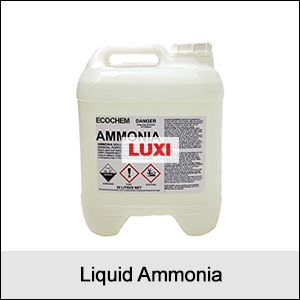Liquid Ammonia
1. Properties of Liquid Ammonia:
- Chemical Formula: NH3.
- Physical State:
- A colorless liquid with a pungent, suffocating odor.
- Boiling point: -33.34°C (-28.01°F).
- Freezing point: -77.73°C (-107.91°F).
- Solubility: Highly soluble in water, forming ammonium hydroxide (NH4OH).
- Density: Approximately 0.681 g/cm3 at -33°C.
- Reactivity:
- Acts as a weak base and reacts with acids to form ammonium salts.
- Combustible under certain conditions, producing nitrogen and water.
- Corrosive to certain materials, especially copper and zinc.
2. Applications of Liquid Ammonia:
- Industrial Uses:
- Fertilizer Production: A key component in the manufacture of urea and other nitrogen-based fertilizers.
- Refrigeration: Used as a refrigerant in industrial cooling systems due to its high efficiency.
- Chemical Manufacturing: Utilized in producing nitric acid, ammonium nitrate, and other chemicals.
- Laboratory Uses:
- Serves as a solvent in certain chemical reactions.
- Used in analytical chemistry for qualitative and quantitative analysis.
- Energy Storage:
- Explored as a potential energy carrier in hydrogen storage and transportation.
- Cleaning and Purification:
- Used in cleaning solutions for industrial and household purposes.
3. Safety and Handling of Liquid Ammonia:
- Hazards:
- Corrosive: Can cause chemical burns to skin and eyes.
- Toxic: Inhalation of vapors can cause respiratory irritation and lung damage.
- Flammable: Combustible in air under certain conditions.
- Protective Measures:
- Use in a well-ventilated area or fume hood to minimize vapor exposure.
- Wear protective equipment, including gloves, goggles, and respiratory protection when handling.
- First Aid:
- Skin Contact: Rinse with water for at least 15 minutes and remove contaminated clothing.
- Eye Contact: Flush with water immediately and seek medical attention.
- Inhalation: Move to fresh air and seek emergency medical care if symptoms persist.
4. Storage:
- Store in tightly sealed, corrosion-resistant containers, such as steel or specific alloys.
- Keep in a cool, well-ventilated area, away from heat sources and incompatible substances like acids and halogens.
- Label containers clearly and ensure appropriate safety measures are in place.
5. Common Uses in Concentrated and Diluted Forms:
- Concentrated Liquid Ammonia: Used in industrial refrigeration and chemical manufacturing.
- Diluted Liquid Ammonia: Found in household cleaning products and laboratory applications.



